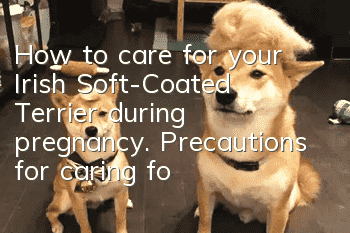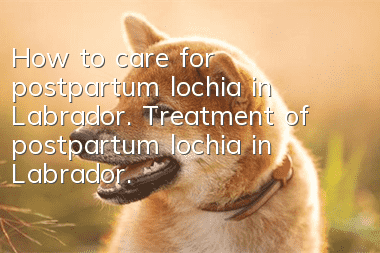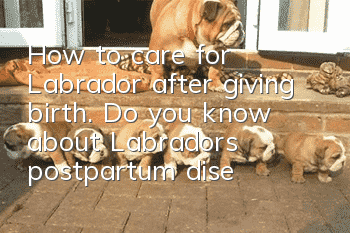How to care for your Irish Soft-Coated Terrier during pregnancy. Precautions for caring for your Irish Soft-Coated Terrier during pregnancy.

In the early stages of pregnancy, Irish Soft-Coated Terrier should pay attention to nutrition and deworming
Around the 30th day of pregnancy, medication should be taken to expel roundworms and tapeworms to avoid infecting the fetus and puppies. The nutrition of the female dog during pregnancy is important. It plays a decisive role in the health of the female dog, ensuring the normal development of the fetal dog, preventing miscarriage, and the secretion of the female dog's milk. Pregnant female dogs should be fed foods with higher nutritional value to increase the protein, heat energy, calcium and phosphorus content in the diet. In the early stages of pregnancy (within about 35 days), pregnant female dogs can be raised according to the original feeding methods.The Irish Soft-Coated Terrier should pay attention to exercise in the middle period
Ensure that the female dog has enough food and water every day, and can switch to puppy food (puppy food is more nutritious), for example: before eating a handful of dog food at one meal If so, I will give it two handfuls at a time, but I can’t overeat it!! Eat some vegetables, cucumbers and cabbage every day (just wash them and eat them raw, wash them and soak them, be sure to wash them). One egg yolk (boiled egg yolk) a day. The light yellow supplements lecithin and is highly nutritious to prevent excessive hair loss after childbirth.PS: Don’t eat the bones to avoid danger! Chicken liver cannot be eaten at this time, it is not good for the female dog (my dog ate a little chicken liver before she was about to give birth, and she pooped immediately. There is blood, but it is fine. The doctor told Irish Soft-Coated Terrier not to eat chicken liver during pregnancy)
Exercise appropriately every day, go out for a walk, and bask in the sun. Going out for a walk will enhance your Irish Soft-Coated Terrier's physical strength, which will help your Irish Soft-Coated Terrier give birth smoothly and avoid dystocia (make sure you walk for about 15 minutes as usual every day, and remember to bring water for your Irish Soft-Coated Terrier to drink when you go out). Walking more can help breast release.
Baking in the sun can also promote calcium absorption. Calcium supplement, take one calcium tablet a day (just buy the kind that Irish Soft-coated Terriers eat at the pet hospital, a bottle costs more than 20 yuan. You can also take liquid calcium for human consumption). You can appropriately supplement vitamin B complex and vitamins.
Just eat enough every day. Don’t let your Irish Soft-coated Terrier eat too much to prevent the baby from growing big and fat (Maltese dogs always have a hard time giving birth, and excessive physical exertion will cause dystocia. , bringing danger to both the Irish Soft-Coated Terrier and the baby).
Precautions before the Irish Soft-Coated Terrier gives birth
Before giving birth (usually in the early morning), you should stay with the Irish Soft-Coated Terrier as much as possible. The Irish Soft-Coated Terrier will start to tremble and will find a darker corner to burrow in. At this time, you need to take out the prepared birthing box and put the Irish Soft-Coated Terrier into it (the one I bought has a dog cage with base mats and clean old clothes laid out in the cage. The Irish Soft-Coated Terrier will scratch it by itself. Planing makes it more comfortable). PS: Don’t use the old clothes at home nowSort out the small mats, wash them, expose them to the sun and store them for easy use. The more the better, because after the Irish Soft-coated Terrier gives birth, body fluids will flow out and wet the bedding. You should change them in time to keep them dry. The baby will live in the birth box after birth, and the bedding must be changed for a period of time to prevent the mother dog and baby from contracting skin diseases due to moisture. If you don’t have a cage, just find a cardboard box that is suitable for your Irish Soft-Coated Terrier. The bigger the better, put 20cm-25cm off the ground on the side of the carton (to prevent the puppy from falling out when it first crawls) and open a box on the left and right that is suitable for the Irish Soft-Coated Terrier to enter and exit. Big mouth.
Precautions when giving birth to an Irish Soft-Coated Terrier
The Irish Soft-Coated Terrier will moan and snort during delivery. The baby will have a membrane when it is born, and the female dog will break it and lick it off. And bite off the umbilical cord, lick the blood clean, and lick the baby dry. (Let the Irish Soft Coat Terrier give birth naturally. Please make sure the owner does not help. Generally, female dogs will behave instinctively, unless the owner does not take action when the female dog does not care at all. The female dog's licking helps to promote the development of the baby's cardiopulmonary and gastrointestinal systems. )During delivery, the Irish Soft-Coated Terrier will be very tired. You should give glucose water appropriately during the interval to replenish the Irish Soft-Coated Terrier's physical strength. If there is an emergency and a baby is born with no afterbirth and basically no breathing, you need to wrap the baby's body with a clean dry towel, clasp the wrapped Irish soft-coated terrier with your hands together, and fix it. Shake the baby's head downward hard to shake out the liquid that has entered the baby's mouth and nose (so the head must be fixed so that the head and body are in a straight line. The head must not be like a trough. If you throw it away, the baby's neck will be broken, and the baby will be thrown directly to death). When it is breathing, put it next to the Irish Soft Coat Terrier and let the female dog lick it well.
Random articles
- What are the disadvantages of raising huskies? Do you still dare to think about raising a demolition office director?
- When is the best time to neuter a golden retriever? Do you know the pros and cons of neutering a golden retriever?
- What are the advantages of Bago? No wonder Bago is becoming more and more popular.
- What do you need to prepare for raising a dog? These are enough
- How to choose dog shower gel? What should you pay attention to when bathing your dog?
- How to tell if your dog is in good health? Do you know how to judge?
- What should I do if Corgi doesn’t eat? The reason why Corgi doesn’t eat may be because of illness.
- What are the shortcomings of Samoyed? There is also a little devil living inside the smiling angel.
- What should you pay attention to when raising a corgi? Do you know these?
- Which dogs are more loyal and suitable to be kept as companion dogs at home?



